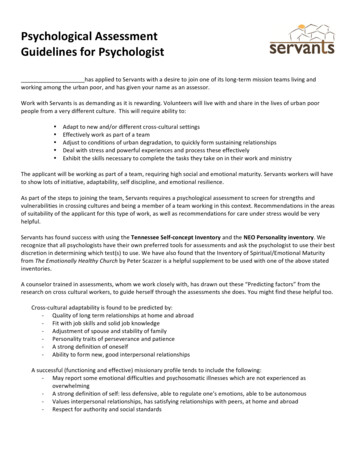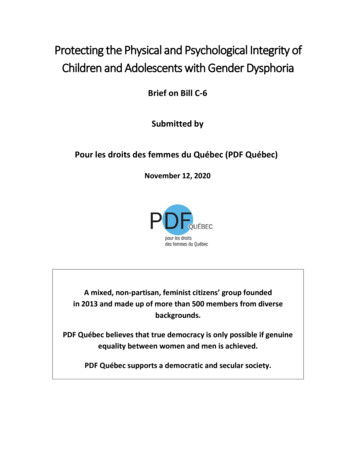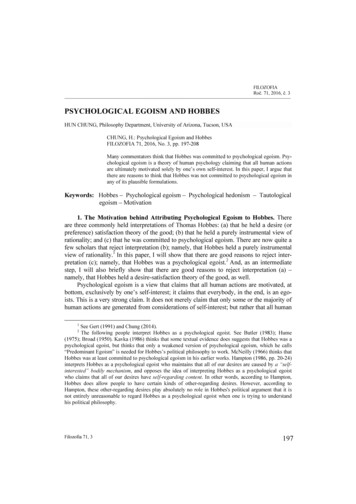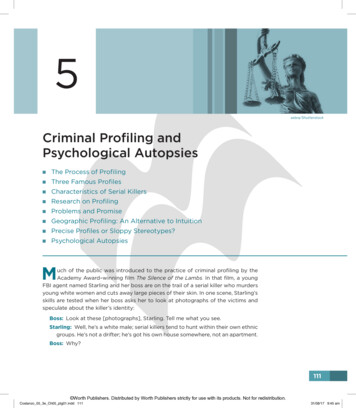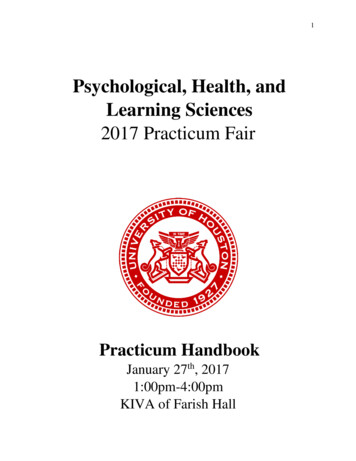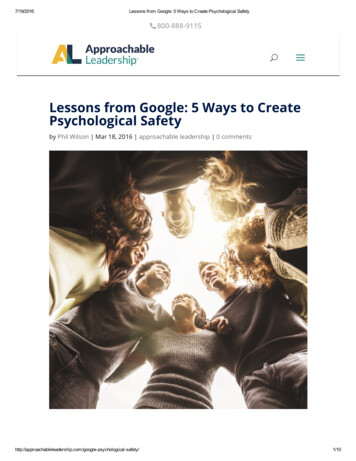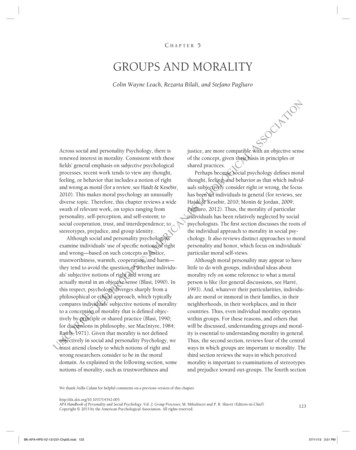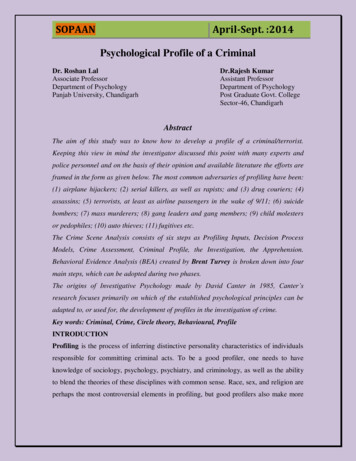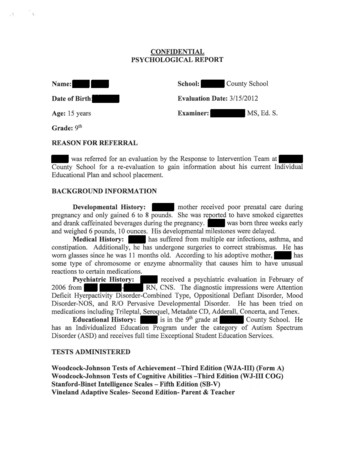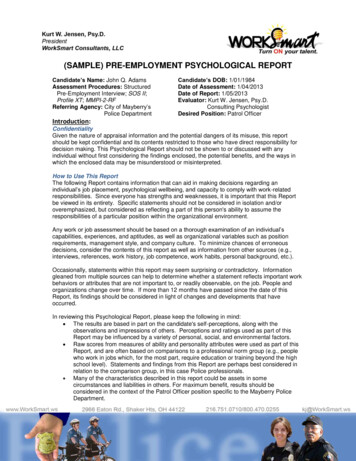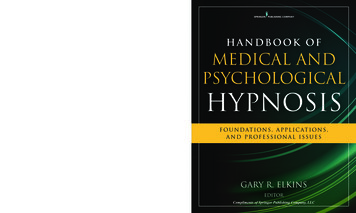
Transcription
HANDBOOK OFHYPNOSISELKINSMEDICAL AND PSYCHOLOGICALF O U N D AT I O N S , A P P L I C AT I O N S , A N D P R O F E S S I O N A L I S S U E SPhD, ABPP, ABPHEDITORA unique, state-of-the-art, interdisciplinary resource on clinicalhypnosis in psychology and medicineThe guide also examines the history and foundations of hypnosis, myths and misconceptions, patient screening,and dealing with resistance to the use of hypnosis. It examines a variety of hypnotherapy systems ranging fromhypnotic relaxation therapy to hypnoanalysis. With each application the text includes relevant research, specificinduction techniques, and an illustrative case example. Additionally it covers professional issues, certification,hypnosis in the hospital, and placebo effects.KEY FEATURES: P resents state-of-the-art hypnosis research and applications for a wide range ofpsychological and medical disorders E ncompasses information on 70 disorders with relevant research, intervention techniques,and case examples A uthored by an international cadre of experts P rovides an interdisciplinary perspective of both the mental health and medical communitiesHANDBOOK OFHANDBOOK OFhis is the only up-to-date, comprehensive interdisciplinary resource on clinical hypnosis research andapplications in psychology and medicine. Authored by hypnosis experts worldwide, it encompasses state-ofthe-art scholarship and techniques for hypnotic treatments along with hypnosis transcripts and case examples forall major psychological disorders and medical conditions. In easily understandable language, this desk referenceaddresses theories, neurophysiology of hypnosis, hypnotherapy screening, measurement of hypnotizability,professional issues, and ethics. Individual chapters present hypnotic inductions to treat 70 disorders includinganxiety, depression, pain, sleep problems, phobias, fibromyalgia, irritable bowel syndrome, menopausal hotflashes, Parkinson’s disease, palliative care, tinnitus, addictions, and a multitude of other common complaints.HYPNOSISTMEDICAL AND PSYCHOLOGICALGARY R. ELKINS,MEDICAL ANDPSYCHOLOGICALHYPNOSISF O U N D AT I O N S , A P P L I C AT I O N S ,AND PR OFESSIONAL ISSUES A ddresses certification, ethics, and other professional issuesISBN 978-0-8261-2486-911 W. 42nd StreetNew York, NY 10036-8002www.springerpub.comGARY R. ELKINSEDITOR9 780826 124869Compliments of Springer Publishing Company, LLC
Resistance: Solving ProblemsDuring Hypnotic Inductions9C H A P T E RDan ShortThis chapter offers a scientific perspective on the variety of problems that might emerge between a patientand practitioner during hypnotic induction. I hesitateto use the word resistance because of its implication that failure in therapy is always the fault of thepatient. This term has also become associated withhighly speculative assumptions of unconscious sabotage. Using a broader problem-solving perspective,this chapter focuses attention on all members of thedyad to better determine which actions, emotions, orbeliefs are interfering with desired outcomes.Clinical hypnosis is essentially a cooperativeendeavor, in which the priming of unconscious associations combines with the creation of a deep expectation that therapeutic change will occur. With thisdefinition, it is apparent that effective hypnotic problem solving remains balanced upon a fulcrum of trustand voluntary consent. This differentiates clinicalhypnosis from hypnosis used by entertainers, by cultrecruiters (Hassan, 2012), or by Central IntelligenceAgency (CIA) interrogators (Ross, 2007). Whenwriting about the subject of resistance in clinicalhypnosis, Weitzenhoffer (1989) warned that aboveall else, “a subject should be willing to be hypnotized, have confidence and trust in the hypnotist,and have a readiness for inner changes, especiallychanges implemented by an outer agent” (p. 140).For these reasons, expert practitioners seek confirmation that the patient wants to be hypnotized orhas a continuing desire to be hypnotized. Accordingto Christenson (1958),It will be found, even with experienced subjects,that if they are not in the mood to be hypnotized,there is no point in going further. . . . In fact, it isbest to concede to the new subject that if he doesnot wish to be hypnotized, he cannot be forced.(p. 38)When the patient feels invited to participate ina process that is permissive, collaborative, andfounded on a respect for his or her goals, there isa decreased likelihood that problems will occur(Fromm, 1980).FEARExperts agree that fear is one of the most commonreasons for resistance to induction (Frauman, Lynn,& Brentar, 1993; Weizenhoffer, 1989; Yapko,2013) and the most common fear is of the hypnotic state itself. For those who have never experienced hypnosis or have only seen it demonstratedin comedy clubs, the prospect of being hypnotizedmay induce panic. Such individuals may fear losingcontrol, revealing embarrassing secrets, developingexcessive dependency, or having to comply withthe practitioner’s every command. Confidence canbe increased by offering the patient the option ofmaintaining full awareness and control over his orher actions, including the ability to open the eyesor lift a finger to stop the induction. Another possibility is to offer the option of “waking hypnosis,”so that the patient can keep his or her eyes open,or the option of limiting the scope of the trance toone small part of the patient’s body, such as a handor an arm (Short, Erickson, & Erickson-Klein,2005), which is easily accomplished using ideomotor signaling or other suggestions for automaticresponses that the patient can observe. Anotherpiecemeal approach is to invite the patient to closeher eyes and merely imagine what trance will belike, what the practitioner might do to improvethe experience, and what suggestions will be mosthelpful to achieve her goals. This exercise oftenCopyright Springer Publishing Company, LLC
78nI: FOUNDATIONS OF MEDICAL AND PSYCHOLOGICAL HYPNOSISreveals fears and misconceptions that inhibit fullparticipation (Frauman, Lynn, & Brentar, 1993).Dedicating some time to this type of preinductionactivity helps prepare the patient with the information needed to set his or her mind at ease. It alsodefines the situation as one in which the patient isan important contributor with power to alter thecourse of events, if necessary.Another common fear is the fear of failure. Thisfear may be felt by the patient, the practitioner, orboth. Patients who have tried almost every othermethod of treatment, without success, may verbalize their doubt that they can go into trance or theymay try to avoid failure by seeking to delay the procedure. Performance anxiety is likely to escalate withpressure, for instance, if the patient gets the idea thattrance induction is a test of whether therapy, as awhole, will succeed. It is important to honor all of thepatient’s requests, for instance, stopping the induction if the patient does not feel ready. If this occurs,the therapy can be temporarily shifted to anotherform of treatment, such as counseling, and returningto hypnosis at a later time. Confidence can also beincreased by having hypnotic responding modeled forthe patient, a strategy that dates back to Liebault’swork in Nancy, France.For the practitioner, it is important to be able totolerate fear of failure and to accept the possibilityof making small mistakes. Other fears that interferewith a confident induction procedure include thepractitioner’s fear of power, fear of the unexpected,or fear of disapproval from others. Ironically, overfocusing on the nuances of hypnotic induction orthe depth of trance tends to increase anxiety whiledistracting attention from the more importantquestion of how hypnosis is going to support theneeds and goals of the patient. For these reasons,it is advisable not to worry about the intricacies ofa technique or to become overly concerned withflawless execution. As long as patients know thatthe clinician is entirely focused on their well-being,they are generally forgiving of small mistakes andjust as eager to see treatment methods succeed.PROBLEMATIC EXPECTATIONSAs with fearful feelings, unrealistic expectations ofwhat will occur during hypnosis (e.g., the loss of allawareness, a complete amnesia for the experience,or the loss of all volitional control) should beaddressed prior to induction so that unfulfilledexpectancies do not result in the patient inferringthat he or she cannot be hypnotized (Overholser,1988). Failure to correct erroneous beliefs oftenresults in the patient declaring, “I must not havebeen hypnotized. I heard every word you said!” Ifmagical expectations are not addressed, it is lesslikely that the patient will be able to recognize orappreciate small gains achieved during trance.Before induction, it is important to carefullyassess the patient’s history of hypnotic experiencesand subsequent attitudes. Relevant details includepatients’ perceptions of how deeply they were hypnotized, whether the experience was enjoyable,how the patients responded to various suggestions,what was most helpful or what was not helpful,and what sensations were experienced (Frauman,Lynn, & Brentar, 1993). This knowledge enablesthe practitioner to select inductions and hypnotictechniques that are compatible with the patient’sexpectancies. Experienced practitioners have longknown that if a subject truly believes a methodwill hypnotize him, then a surprisingly widevariety of methods can serve as effective induction (Weitzenhoffer, 1989). During the first hypnotic session, it is advisable to allow the patientto succeed with easy suggestions, such as imagery,changes in skin temperature, and psychomotormovement, before moving to more complex experiences such as glove anesthesia, positive or negative hallucinations, and hypnotic amnesia. Successwith early responsiveness to suggestion strengthensexpectations, thereby ensuring greater responsiveness to subsequent suggestions (Kirsch, 1990).Ironically, a problem can be defined as anydiscrepancy between what is expected and whatis occurring. Thus, the more flexible and openminded the practitioner, the fewer the problemsthat are likely to be encountered. Perhaps the mostcommon problematic expectation held by practitioners of hypnosis is that a favored induction technique should work equally well with all patients.However, dating back to the earliest research onhypnosis, luminaries such as Bernheim (1889/1947)and Janet (1925) have argued that methods, whichwork very well with some subjects, may not workequally well with others, and that even those whohave responded well to a particular technique mayprefer a different technique on a different occasion.Copyright Springer Publishing Company, LLC
9: RESISTANCE: SOLVING PROBLEMS DURING HYPNOTIC INDUCTIONSAlso, both the therapist and patient should haverealistic expectations for the experience of hypnosis. For example, expectations such as that hypnosis requires absolute compliance to be effectivecan be problematic. Realistic expectations comefrom recognizing that the hypnotic state does notinvolve sleep or a loss of consciousness. Accordingto Erickson (1948), “Hypnosis does not change theperson, nor does it alter his past experiential life. Itserves to permit him to learn more about himselfand to express himself more adequately” (p. 514).And as stated by Wolberg (1948), “It has manyvalues; but it does have limitations in terms of theindividual’s existing motivations and his capacitiesfor change. Therapeutic failures occur with hypnosis as with any other form of therapy” (p. 418).MISCOMMUNICATIONPerhaps one of the most hapless problems that canoccur during hypnotic induction is that of miscommunication. In some instances, the patient istrying to cooperate but does not understand whatthe practitioner is requesting, because the suggestion was either too vague or stated in too narrowterms. During trance, suggestions should be simpleand repeated more than once. The more complicated a suggestion, the more difficult it will befor the patient to carry it out. Another possibilityis that the patient is responding in a very literaland circumscribed manner. For instance, a patientwho is told to watch her arm levitate may watcha hallucinated arm movement without any physical changes to the position of her arm. Or a person who is told to “feel more and more sleepy”may not close his eyes until being told specificallyto do so. This is especially likely to happen during hypnosis with children (Short, 1999). It wouldbe a serious mistake to interpret these behaviorsas unconscious resistance when what is actuallyoccurring is unexpected compliance with a miscommunication by the practitioner. For these reasons,suggestions should be brief, precise, and worded asclose as possible to the known habits and thoughtsof the patient, thereby reducing the likelihood ofmiscommunication.Because communication works best as a twoway street, it is helpful to invite the patient totalk during trance induction so that you have an79better understanding of his or her subjective experiences and emerging hypnotic realities. Similarly,increased observation results in greater sensitivityto the needs of the patient and increased responsiveness. When seeking to understand an individual’s emotional experience, it is particularlyimportant to study the movements of the eyes andface, which yield more information than spokenlanguage (Ekman, 2003; Hess, 1965). A suddenlook of concern may indicate problems with wordchoice. For instance, some patients will respondviolently to the idea of being “hypnotized” but theydo not mind the thought of “going into a trance”just as some patients are terrified of being labeledas “crazy” but do not mind being identified as“mentally ill” (Short, Erickson, & Erickson-Klien,2005). The primary solution for any problem withcommunication is to gather more information withthe hope of increasing empathic understanding.POWER STRUGGLESAccording to Erickson (1956), appa
Authored by hypnosis experts worldwide, it encompasses state-of-the-art scholarship and techniques for hypnotic treatments along with hypnosis transcripts and case examples for all major psychological disorders and medical conditions. In easily understandable language, this desk reference addresses theories, neurophysiology of hypnosis, hypnotherapy screening, measurement of hypnotizability .

